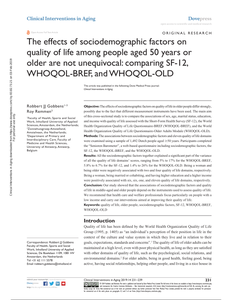Objective: The effects of sociodemographic factors on quality of life in older people differ strongly, possibly due to the fact that different measurement instruments have been used. The main aim of this cross-sectional study is to compare the associations of sex, age, marital status, education, and income with quality of life assessed with the Short-Form Health Survey (SF-12), the World Health Organization Quality of Life Questionnaire-BREF (WHOQOL-BREF), and the World Health Organization Quality of Life Questionnaire-Older Adults Module (WHOQOL-OLD). Methods: The associations between sociodemographic factors and eleven quality of life domains were examined using a sample of 1,492 Dutch people aged $50 years. Participants completed the “Senioren Barometer”, a web-based questionnaire including sociodemographic factors, the SF-12, the WHOQOL-BREF, and the WHOQOL-OLD. Results: All the sociodemographic factors together explained a significant part of the variance of all the quality of life domains’ scores, ranging from 5% to 17% for the WHOQOL-BREF, 5.8% to 6.7% for the SF-12, and 1.4% to 26% for the WHOQOL-OLD. Being a woman and being older were negatively associated with two and four quality of life domains, respectively. Being a woman, being married or cohabiting, and having higher education and a higher income were positively associated with six, six, one, and eleven quality of life domains, respectively. Conclusion: Our study showed that the associations of sociodemographic factors and quality of life in middle-aged and older people depend on the instruments used to assess quality of life. We recommend that health care and welfare professionals focus particularly on people with a low income and carry out interventions aimed at improving their quality of life.
DOCUMENT

Alongside the growing number of older persons, the prevalence of chronic diseases is increasing, leading to higher pressure on health care services. eHealth is considered a solution for better and more efficient health care. However, not every patient is able to use eHealth, for several reasons. This study aims to provide an overview of: (1) sociodemographic factors that influence the use of eHealth; and (2) suggest directions for interventions that will improve the use of eHealth in patients with chronic disease. A structured literature review of PubMed, ScienceDirect, Association for Computing Machinery Digital Library (ACMDL), and Cumulative Index to Nursing and Allied Health Literature (CINAHL) was conducted using four sets of keywords: “chronic disease”, “eHealth”, “factors”, and “suggested interventions”. Qualitative, quantitative, and mixed-method studies were included. Four researchers each assessed quality and extracted data. Twenty-two out of 1639 articles were included. Higher age and lower income, lower education, living alone, and living in rural areas were found to be associated with lower eHealth use. Ethnicity revealed mixed outcomes. Suggested solutions were personalized support, social support, use of different types of Internet devices to deliver eHealth, and involvement of patients in the development of eHealth interventions. It is concluded that eHealth is least used by persons who need it most. Tailored delivery of eHealth is recommended
DOCUMENT

In deze literatuurstudie werden vier databanken doorzocht met behulp van trefwoorden zoals chronic disease, e-health, factors en suggested interventions. Kwalitatieve, kwantitatieve en mixed methods-studies werden meegenomen. Uit de data van de 22 artikelen die werden geïncludeerd in de studie, blijken leeftijd, geslacht, inkomen, opleidingsniveau, etnische achtergrond en woonplaats (stad of platteland) in meer of mindere mate van invloed te zijn op het gebruik van e-health. Het artikel is een Nederlandstalige samenvatting van het artikel: Reiners, Sturm, Bouw & Wouters (2019) uit Int J Environ Res Public Health 2019;16(4)
DOCUMENT
